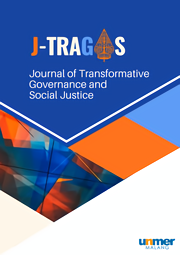Quadruple Helix Model in Building Communalism and Social Resilience in Handling Poverty in Rural Communities
DOI:
https://doi.org/10.26905/j-tragos.v1i1.9177Keywords:
Quadruple Helix, Social Security, Poverty Reduction, Governance, Rural CommunitiesAbstract
Poverty is a major problem in a country's development policy. Various strategies were implemented in an effort to reduce poverty, including utilizing economic resources ement of social resources as a new form of actor involvement in the quadruple helix model in handling local poverty problems. This method is a qualitative research paradigm is an approach used in the process of collecting data related to the involvement of social resources in social security to reduce local poverty rates. Data were analyzed interactively and triangulation was used to obtain validity. This article is the result of research on poverty management in rural communities. The high poverty gap between urban and rural communities encourages this research to be carried out. The multidimensional causes of poverty encourage a paradigm shift in handling, namely by involving multi actors through the quadruple helix model to build communalism and social resilience. The results of this study indicate that the social spirit generated from social institutions can be used as the glue for communalism in poverty reduction, so that it becomes a helix in government efforts to reduce poverty. Social togetherness as a form of solidarity from community groups present in the behavior and actions of groups is a social resource that is capable of creating community social resilience so that it can move togetherness in handling local poverty problems. to stimulate the income of poor groups of people. A structural approach is taken by the government in carrying out a poverty alleviation strategy. This study describes the involvement of social resources as a new form of actor involvement in the quadruple helix model in handling local poverty problems. This method is a qualitative research paradigm is an approach used in the process of collecting data related to the involvement of social resources in social security to reduce local poverty rates. Data were analyzed interactively and triangulation was used to obtain validity. This article is the result of research on poverty management in rural communities. The high poverty gap between urban and rural communities encourages this research to be carried out. The multidimensional causes of poverty encourage a paradigm shift in handling, namely by involving multi actors through the quadruple helix model to build communalism and social resilience. The results of this study indicate that the social spirit generated from social institutions can be used as the glue for communalism in poverty reduction, so that it becomes a helix in government efforts to reduce poverty. Social togetherness as a form of solidarity from community groups present in the behavior and actions of groups is a social resource that is capable of creating community social resilience so that it can move togetherness in handling local poverty problems.Downloads
References
Asheim, B. (2007). Differentiated knowledge bases and varieties of regional innovation systems. Innovation. https://doi.org/10.1080/13511610701722846
Bankins, S., Denness, B., Kriz, A., & Molloy, C. (2017). Innovation Agents in the Public Sector: Applying Champion and Promotor Theory to Explore Innovation in the Australian Public Service. Australian Journal of Public Administration. https://doi.org/10.1111/1467-8500.12198
Carayannis, E. G., & Campbell, D. F. (2014). Developed democracies versus emerging autocracies: arts, democracy, and innovation in Quadruple Helix innovation systems. Journal of Innovation and Entrepreneurship. https://doi.org/10.1186/s13731-014-0012-2
Carayannis, E. G., & Campbell, D. F. J. (2010). Triple Helix, Quadruple Helix and Quintuple Helix and How Do Knowledge, Innovation and the Environment Relate To Each Other? International Journal of Social Ecology and Sustainable Development. https://doi.org/10.4018/jsesd.2010010105
Cobbinah, P. B., Black, R., & Thwaites, R. (2013). Dynamics of Poverty in Developing Countries: Review of Poverty Reduction Approaches. Journal of Sustainable Development. https://doi.org/10.5539/jsd.v6n9p25
Colapinto, C., & Porlezza, C. (2012). Innovation in Creative Industries: From the Quadruple Helix Model to the Systems Theory. Journal of the Knowledge Economy. https://doi.org/10.1007/s13132-011-0051-x
Cooke, P., Uranga, M. G., & Etxebarria, G. (1997). Regional innovation systems: Institutional and organisational dimensions. Research Policy. https://doi.org/10.1016/s0048-7333(97)00025-5
Hasche, N., Höglund, L., & Linton, G. (2019). Quadruple helix as a network of relationships: creating value within a Swedish regional innovation system. Journal of Small Business and Entrepreneurship. https://doi.org/10.1080/08276331.2019.1643134
Höglund, L., & Linton, G. (2018). Smart specialization in regional innovation systems: a quadruple helix perspective. R and D Management. https://doi.org/10.1111/radm.12306
Ivanova, I. (2014). Quadruple Helix Systems and Symmetry: A Step Towards Helix Innovation System Classification. Journal of the Knowledge Economy. https://doi.org/10.1007/s13132-014-0201-z
Leydesdorff, L. (2012). The Triple Helix, Quadruple Helix, and an N-Tuple of Helices: Explanatory Models for Analyzing the Knowledge-Based Economy? Journal of the Knowledge Economy. https://doi.org/10.1007/s13132-011-0049-4
Leydesdorff, L., & Ivanova, I. (2016). “Open innovation†and “triple helix†models of innovation: Can synergy in innovation systems be measured? Journal of Open Innovation: Technology, Market, and Complexity. https://doi.org/10.1186/s40852-016-0039-7
Ludvall, B.-A., & . (2011). The Changing Global Knowledge Landscape and the Need for a Transatlantic Vision and a New Pragmatism Bengt- Ã…ke Lundvall. Sciences-New York.
Miller, K., Mcadam, R., Moffett, S., Alexander, A., & Puthusserry, P. (2016). Knowledge transfer in university quadruple helix ecosystems: An absorptive capacity perspective. R and D Management. https://doi.org/10.1111/radm.12182
Piirainen, T., & Koski, P. (2004). Integrating workplace development policy and innovation policy: A challenging task. https://doi.org/10.1075/dowi.15.18pii
Sen, A. (2005). Human Rights and Capabilities. Journal of Human Development. https://doi.org/10.1080/14649880500120491
Downloads
Additional Files
Published
How to Cite
Issue
Section
License
Authors who publish in this journal agree to the following terms:
(1) Copyright of the published articles will be transferred to the journal as the publisher of the manuscripts. Therefore, the author confirms that the copyright has been managed by the journal.
(2) Publisher of the Journal of Transformative Governance and Social Justice (J-TRAGOS) is the University of Merdeka Malang.
(3) The copyright follows Creative Commons Attribution “ShareAlike License (CC BY SA): This license allows to Share” copy and redistribute the material in any medium or format, Adapt” remix, transform, and build upon the material, for any purpose, even commercially.




